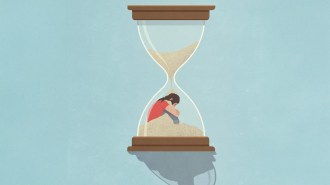Running is contagious among those with the competitive bug

Can behaviors really be contagious? Runners log more miles when their friends do — especially if they want to stay leader of the pack, a new study finds.
monkeybusinessimages/iStockphoto
- More than 2 years ago
People may think they act independently. But we catch social behaviors faster than colds. Whether or not we vote, try a new food or wear clear plastic pants will have something to do with whether other people are doing it. Unfortunately, it’s often hard to prove exactly how contagious a particular behavior is, or which behaviors will actually spread.
A new study shows that among runners using a fitness social network, logging miles is infectious — if the runner you’re comparing yourself to is slightly worse than you. The work shows a clever new way to determine if a behavior is socially contagious. But the results also confirm something about runners: We might be a little too competitive.
Glance at any group of kids with fidget spinners or teens wearing the same brand of shoes, and it’s easy to buy into the idea of social contagions. But it’s actually not so simple to distinguish between that kind of peer influence and other outside factors. says Johan Ugander, an applied mathematician at Stanford University. It’s easy for marketers to say they want something to go viral. But it’s a lot harder to be confident that the thing that’s spreading is really a social contagion and not a common factor like location or a group of people with common interests.
For one thing, birds of a feather really do flock together. People become friends because they have things in common. You might share an important article to Facebook, and find a friend has shared the same article 20 minutes later. But is that because you influenced your friend? Or because you have the same interests and read the same kind of articles, and you just happened to see it 20 minutes before they did?
Similarly, people tend to have friends who are near them geographically. So if two neighbors gain weight, Ugander notes, it could be “because the McDonald’s opened down the street, not because I gained weight then you gained weight.”
To get around this problem of homophily, Sinan Aral, a computational social scientist at MIT, decided to look at a single behavior — running. “Running is one of the most pervasive forms of this type of exercise,” he says. “I thought it would be most generalizable.”
Runners also like to log their miles and share them with their peers. Aral was able to get data from one of several social media platforms designed for jogging buffs. Aral can’t disclose the exact app or program he used in the study (and received some funding from), but there are a few social apps out there that fit the bill, including MapMyRun, RunKeeper and Strava. Aral ended up with a vast, anonymized dataset of more than 1.1 million runners who logged more than 359 million kilometers (223 million miles) over five years.
To figure out if running is contagious, there would have to be a way to make some people run and other people stay home. “The ideal study to show [a causal effect] would be to go around with a cattle prod, prodding some people to exercise more,” but leaving others alone, Aral says. “But that’s not an experiment you can run.” (Obviously.)
So Aral and colleagues used the weather as their cattle prod. Good weather beckons a runner outdoors. Rain, snow, sleet or hail will keep a runner off the street. The researchers combed through data, noting what the weather was like on a given day and how far a runner went. They then compared that runner’s logs to their friends in other cities — places far enough away that the weather would be different. With the weather serving as the prod for some to put on their running shoes or keep others at home, the scientists got a good idea of who socially infected who with the running bug.
They found that for every additional kilometer run by someone’s distant friends, the runner would add another 0.3 km (0.18 mi). Timewise, a friend spending an additional 10 minutes running will inspire an extra three minutes in someone else, Aral and his group reported April 18 in Nature Communications.
But social contagion didn’t affect everyone the same way. The runners most influenced were those who compared themselves to runners slightly worse than they were. “In the loose analogy of a race, I’m more motivated by the guy behind me than I am motivated by the person ahead of me,” Aral says.
The study also showed some gender effects. Men were most influenced by other men, but were also ready to outrace the women. In contrast, women did not tend to be influenced by men. “There have been experimental studies showing men are more competitive with one another, while women are more self-directed and motivated by internal factors,” Aral says. But that doesn’t mean that women aren’t competitive. Women were just influenced by other women.
“It’s usually very difficult to identify causal effects from correlational data, in the absence of a randomized controlled trial,” says Edoardo Airoldi, a statistician at Harvard University. The data in this study may not translate to other behaviors — even to other forms of exercise. But that isn’t the point. The beauty, Airoldi says, is in the methods. “People should know you can use the weather as an instrument to uncover patterns of human behavior that are otherwise hard to elicit,” he says.
Ugander is also a fan of the new study, but he notes that this doesn’t mean all social behaviors, or even all sports, will prove similarly contagious, especially with regard to the gender differences. “It’s not clear that that will generalize to yoga or some other sport with other gender norms,” he says.
We don’t really know what exactly drives social contagion. One theory — the complex contagion theory — posits that costly behaviors (like going for an exhausting run) require a lot of signals from a lot of people. In other words, the more people in your network are running, the more likely you are to run.
Another theory developed by Ugander’s group posits that it’s not quantity that matters, but variety, a theory called structural diversity. Your family all going running is one thing. A family member, a friend and coworker is another. “If you’re getting it from two people from different parts of your life, say sibling and coworkers, it carries more weight,” Ugander says. “But two coworkers probably got it from each other.”
A third theory suggests that embeddedness — the number of mutual connections — matters most. After all, seeing all your friends virtuously running and knowing that they are also seeing each other live the wholesome life is a lot of peer pressure.
The data from Aral’s group suggests that for running, embeddedness and structural diversity may prove the most catching. “This doesn’t mean the complex theory is wrong,” Aral notes. “We just didn’t see it for running.”
Aral himself is a runner, and admits he’s not immune to the social contagion he found. “When I have friends who are close to me in fitness in terms of their level of activity, I may be influenced,” he says. “I also feel like I’d be more influenced by someone who was slightly less of a runner than I am. If they were running more, I would think, ‘Wow, even so-and-so is out there, I need to get out there.’” This social behavior might be catching, but the vulnerable population already has a raging competition infection.







